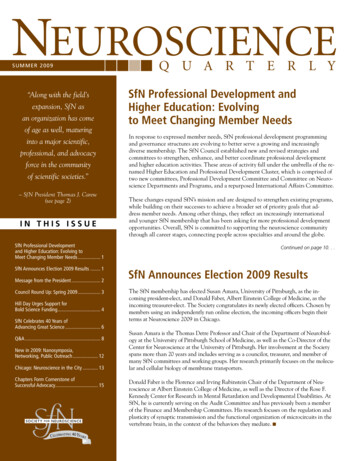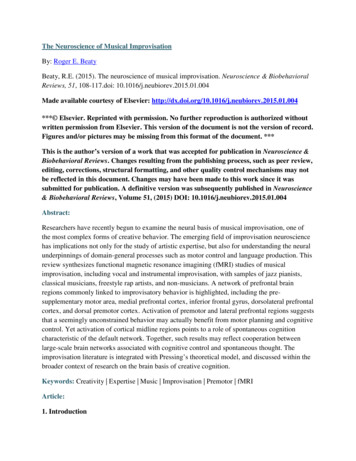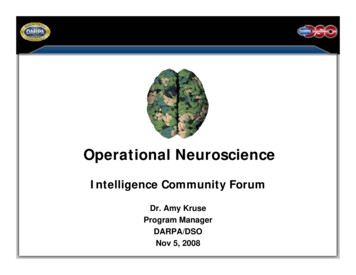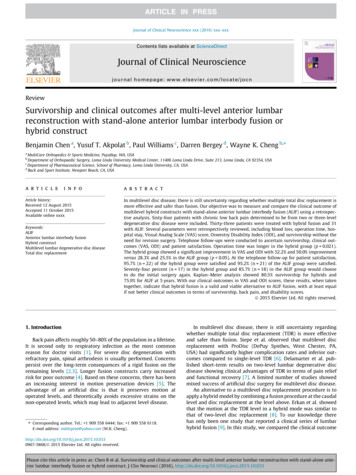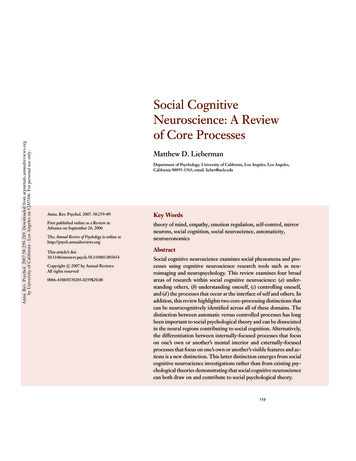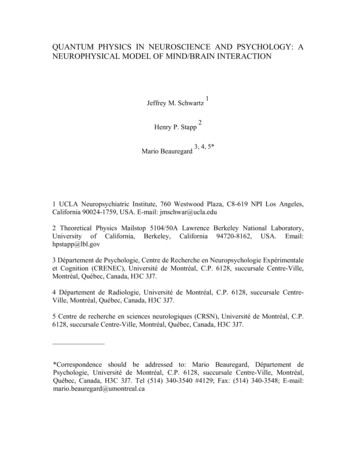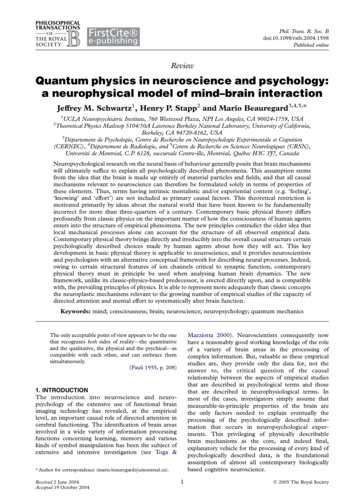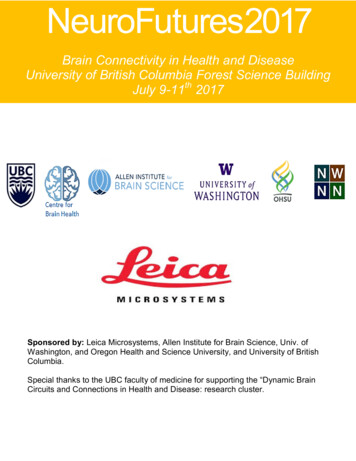
Transcription
NeuroFutures2017Brain Connectivity in Health and DiseaseUniversity of British Columbia Forest Science BuildingJuly 9-11th 2017Sponsored by: Leica Microsystems, Allen Institute for Brain Science, Univ. ofWashington, and Oregon Health and Science University, and University of BritishColumbia.Special thanks to the UBC faculty of medicine for supporting the “Dynamic BrainCircuits and Connections in Health and Disease: research cluster.
July 9-11th, 2017 Forest Sci. BldgUBCSunday, July 96:00pmPublic Lecture & Discussion - Neuroscience and Artificial Intelligence- Auditorium Tim Murphy, University of British Columbia /Amy Bernard, Allen Institute forBrain Science Introduction and moderators Gary Marcus, New York University, "What artificial intelligence can learnfrom the brain and vice versa"7:00-8:30PMReception - AtriumMonday, July 107:45-8:45amRegistration and continental breakfast Forest Sci. Atrium9:00amWelcome and introductory remarks Tim Murphy University of BritishColumbia, NeuroFutures2017 committee – Forest Sci. Auditorium Ann Marie Craig, Ph.D., University of British ColumbiaSheri Mizumori, Ph.D., University of WashingtonTerri Gilbert Allen Inst for Brain ScienceAmy Bernard Allen Inst for Brain ScienceRad Roberts, Ph.D., University of WashingtonBill Rooney, Ph.D., Oregon Health & Science UniversityJane Roskams, Ph.D., UBC 9:05-10:00amOpening keynote - Engineering fluorescent protein probes - AuditoriumModerator: Tim Murphy, University of British ColumbiaLoren Looger, Janelia Research Campus“Tools to follow the brain in action”10:00-10:30am2Morning break - Atrium
10:30am-12:00noon “Recombinant probes and protein/small molecule engineering forneuroscience” -- AuditoriumModerator: Rad Roberts, University of Washington10:30-11:00amRobert Campbell, University of Alberta“Engineering of red-shifted genetically encoded neurophotonics probes”11:00-11:30amAxerio-Cilies, University of British Columbia"In silico drug design for selecting NMDA receptor subtype specificmodulators"11:30am-12noonLance Stewart, University of Washington"De novo protein design: binders, switches, and channels for futureneuroscience applications".12noon-1pmLunch - Atrium1:00-3:00pm“Circuits in behavior” - AuditoriumModerator: Sheri Mizumori, University of Washington1:00-1:30pmRichard Palmiter, University of Washington"A neural circuit that controls appetite and responds to threats."1:30-2:00pmDavid Gire, University of Washington"Neural circuits for processing natural odor scenes".2:00-2:30pmJonathan Epp, University of Calgary"Regulation of circuit stability and memory persistence by adultneurogenesis".2:30-3:00pmEric Turner, University of Washington"The lawless frontiers of the Habenula"3:00-3:30pmCoffee and afternoon break - Atrium3:30-5:00pm“Mesoscale connectivity new methods and approaches” - AuditoriumModerator: Bill Rooney, Oregon Health & Science University3:30-4:00pmJack Waters, Allen Institute for Brain Science"An extended map of retinotopy in mouse neocortex"4:00-4:30pmTianyi Mao, Oregon Health and Science University"Integration of multiple mesoscopic maps for analyzing functional circuitproperties and its plasticity".4:30-5:00pmJennifer Whitesell, Allen Institute for Brain Science"Anatomical correlates for the mouse default mode network and itsvulnerability in Alzheimer's disease".
5:00-7:00pmPoster session 1 and Happy Hour reception - AtriumTuesday, July stration and Continental Breakfast – Forest Sci. atrium“Brain clearing, expansion, and super-resolution technologies”Moderator: Ann Marie Craig, University of British ColumbiaKwanghun Chung, Massachusetts Institute of Technology"Integrated multiscale imaging and phenotyping of intact biologicalsystems".9:30-10:00amJoshua Vaughan, University of WashingtonSuper-resolution microscopy made simple".10:00-10:30amCoffee and morning break, poster session 2 - Atrium10:30-12noon“Exploring brain circuitry by leveraging cell class identity:Approaches in genetic engineering and structural biology” AuditoriumModerator: Amy Bernard, Allen Institute for Brain Science10:30-11:00amTanya Daigle, Allen Institute for Brain Science"New genetic tools for functional analysis of cell types”11:00-11:30amJohn Mich, Allen Institute for Brain Science“Marker discovery and modeling of human brain development".11:30-12:00amMichelle Naugle, Allen Institute for Brain Science"Exploring the synaptic networks of human cortex".12noon-1:30pmLunch and poster session 2 - Atrium1:30-3:30pm4“Circuits in disease models and memory systems” - AuditoriumModerator: Allen Chan, University of British Columbia1:30-2:00pmJodi McBride, Oregon Health and Science University"Changes in brain connectivity in Huntington's disease".2:00-2:30pmShernaz Bamji, University of British Columbia"The X-linked intellectual disability gene DHHC9 and the formation ofneural circuits".
2:30-3:00pmMajid Mohajerani, University of Lethbridge"In vivo optical imaging assessment of mouse cortical-hippocampaldialogue during rest".3:00-3:30pmCathy Rankin, University of British Columbia"High throughput, high resolution machine vision analyses of C.elegansbehavior lead to new insights about learning".3:30-3:45pmBreak - Atrium3:45-4:45pm“Closing Keynote - Imaging Brain Metabolism” - AuditoriumJane Roskams, University of British Columbia ModeratorBrian MacVicar, University of British Columbia Speaker4:45-5:00PMFinal wrap-up and Poster awards - Auditorium
Poster Session 1. July 10th, 2017 please put posters up before 9 AM remove atend of evening poster session.1) Duration dependency of monocular deprivation induced visual plasticity. Seung Hyun Min,Alex Baldwin, Alexandre Reynaud, Robert F. Hess McGill Vision Research, Dept.Ophthalmology, McGill University, Montreal PQ, Canada.2) The X-linked disability Gene, DHHC9, regulates neural circuit formation. Jordan J.Shimell, Bhavin S. Shah, Blair Jovellar, Stefano Brigidi, Igor Tatarnikov, Naila Kuhlmann,Austen Milnerwood, Shernaz X. Bamji. University of British Columbia, Vancouver, BC,Canada.3) Molecular signaling pathways in synaptogenesis. Claire Bomkamp & Ann Marie CraigDepartment of Psychiatry, University of British Columbia, Vancouver, BC, Canada.4) Functionalization of ASD variants of PTEN in rat and Xenopus. Matthew Edwards1,4*, RikiDingwall1,4*, Kathryn Post1,4, Paul Pavlidis2,4, Timothy O’Connor1,4, Catherine Rankin3,4,Douglas Allan1,4, Christopher Loewen1, Shernaz Bamji1,4, Kurt Haas1,4 1) Department ofCellular and Physiological Science, 2) Department of Psychiatry, 3) Department ofPsychology, 4) Centre for Brain Health, The University of British Columbia, Vancouver,BC, Canada5) Investigation of the role of APP in developmental axonal pruning. Andres de Leon 1,2;Aaron Johnstone1,2; Mark Cumming1,2; Julien Gibon1, Philip Barker1. 1) University ofBritish Columbia – Okanagan, BC; 2) McGill University, Montreal, QC, Canada.6) Expand your mind! Super-resolution imaging of brain tissue with conventionalmicroscopes using expansion microscopy. Tyler J. Chozinski, Aaron R. Halpern, HaruhisaOkawa, Hyeon-Jin Kim, Grant J. Tremel, Chenyi Mao, Nan Jiang, Jay Z. Parrish, RachelO. L. Wong, Joshua C. Vaughan. Departments of Chemistry, Physiology and Biophysics,Biology, and Biological Structure, University of Washington, Seattle, WA, USA.7) Measuring glutamate release in Huntington Disease using iGluSnFr, an optogeneticprobe. Ellen T Koch, Cameron L Woodard, Lynn A Raymond. Department of Psychiatry,University of British Columbia, Vancouver, BC, Canada.8) A novel automated home-cage system to assess learning and performance of a skilledmotor task in a mouse model of Huntington’s disease. Cameron L. Woodard 1, FedericoBolaños1, James D. Boyd2, Greg Silasi2,Timothy H. Murphy2, Lynn A. Raymond2 1)Graduate Program in Neuroscience 2) Department of Psychiatry and DjavadMowafaghian Centre for Brain Health, University of British Columbia, Vancouver, BC,Canada.9) Movement initiation in GCaMP6 mice is preceded by stereotyped, multi-second dorsalcortex dynamics. Catalin C. Mitelut1,2,3, Anna X. Luo1,2, Greg Silasi1, Yuki Sekino4, JamieD. Boyd1,2, Federico Bolanos1,2, Nicholas V. Swindale3, Timothy H. Murphy1,2 1) Dept. ofPsychiatry, Kinsmen Lab of Neurological Research, University of British Columbia,Vancouver, BC, Canada. 2) Djavad Mowafaghian Centre for Brain Health, University ofBritish Columbia, Vancouver, BC, Canada. 3) Dept. of Ophthalmology and VisualSciences, University of British Columbia, Vancouver, BC, Canada. 4) Dept. of6
Otorhinolaryngology, Kyushu University, Fukuoka, Japan.10) Automated optogenetic and mesoscopic brain imaging system for the mouse home-cage,Federico Bolanos, Jeffrey Ledue, James D. Boyd, Timothy H. Murphy. DjavadMowafaghian Centre for Brain Health, University of British Columbia, Vancouver, BC,Canada.11) Mesoscale Brain Explorer, a flexible Python-based image analysis and visualization tool;Authors: Dirk Haupt, Matthieu Vanni, Fedrico Bolanos, Jeffrey LeDue, Catalin Mitelut,Timothy Murphy; All Authors are affiliated with both 1) Department of Psychiatry, KinsmenLaboratory of Neurological Research, University of British Columbia, Vancouver, BC,Canada. 2) Djavad Mowafaghian Centre for Brain Health, University of British Columbia,Vancouver, BC, Canada.12) Mesoscale cortical calcium imaging reveals functional hypoconnectivity and regionspecific changes in activity fluctuations in a mouse model of electroconvulsive therapy D.Blair Jovellar, Jeffrey LeDue, Fidel Vila-Rodriguez, Timothy H. Murphy, University ofBritish Columbia, Vancouver, BC, Canada13) Sub-cortical or peripheral nerve spike-triggered cortical mesoscale activity associatedwith specific actions in awake chronic mice. Dongsheng Xiao 1,2, Timothy H Murphy1,2* 1)Department of Psychiatry, Kinsmen Laboratory of Neurological Research, 2) DjavadMowafaghian Centre for Brain Health, University of British Columbia, Vancouver, BC,Canada.14) Spatiotemporal mapping of spontaneous activity in GCaMP6 mice reveals new anatomofunctional boundaries, symmetries and pinwheels of cortical dynamics. Vanni MP, ChanAW, Balbi M, Silasi G, Murphy TH. Department of Psychiatry, University of BritishColumbia, Vancouver, BC, Canada.15) Using single cell widefield to characterize the spatiotemporal properties of the mousevisual cortex. Natalia Mesa. University of Washington, Seattle, WA, USA.16) AAV-PHP.B mediates gene delivery throughout the CNS of mice and rhesus macaquesvia intra-CSF or intra-vascular administration. Jacqueline Domire1, William Liguore1, YunWang1, Dana Button1, Brett Dufour1, 2, Darla Jacob3, Ted Hobbs3, Drew Martin3 and JodiMcBride1,2,4 Divisions of 1) Neuroscience and 3) Comparative Medicine, Oregon NationalPrimate Research Center, Departments of 2) Behavioral Neuroscience and 4) Neurology,Oregon Health and Science University, Portland, OR, USA.17) Multiple measures of short-term tap habituation. Aram Bernardos, James Wong,Catharine Rankin. University of British Columbia, Vancouver, BC, Canada.18) Stress habituation and sex modulate the effects of the 5-HT 1A receptor agonist, 8-OHDPAT, on pre- and post- synaptic function. Presented by Philippe, T. J., Ferland, A.,Chang, J., Yang, Y., Viau, V. University of British Columbia, Vancouver, BC, Canada.19) Stress hormone CORT induced neuroplasticity in the ventral tegmental area. Shuai Liu,Min Qiao and Stephanie Borgland Hotchkiss Brain Institute, University of Calgary, AB,Canada.
20) BioID reveals the robust signaling complexity of neuronal TNF receptors Authors: Mark J.Cumming, University of British Columbia Okanagan, BC, McGill University, QC, EstelleLaurent University of Toronto, ON, Etienne Coyaud University of Toronto, ON, GenevieveDorval, McGill University, Montreal, QC, Brian Raught University of Toronto, ON, andPhilip A. Barker, McGill University, Montreal, QC, Canada.Poster session 2. July 11th, 2017 please put posters up before 9 AM remove at5PM.1) Expression analysis of mouse models and patients of neurodegenerative diseases;Thatra, Nivretta, University of British Columbia, Vancouver; Pavlidis, Paul, University ofBritish Columbia, Vancouver ; Riess, Olaf, University of Tübingen, Germany; Gsponer,Joerg, University of British Columbia, Vancouver, BC, Canada.2) Biomarkers for injury severity in patients with acute traumatic spinal cord injury. SethTigchelaar1, Femke Streijger1, Sunita Sinha2, Stephane Flibotte2, Michael A Rizzuto1,John Street4, Scott Paquette5, Michael Boyd5, Tamir Ailon5, Charles Fisher4, MarcelDvorak4, Jean-Marc Mac-Thiong6, Stefan Parent7, Christopher Bailey8, Sean Christie9,Kendall Van Keuren-Jensen3, Corey Nislow2, Brian K. Kwon1,4. 1) InternationalCollaboration on Repair Discoveries (ICORD), University of British Columbia, Vancouver,British Columbia, Canada; 2) Faculty of Pharmaceutical Sciences, University of BritishColumbia, Vancouver, British Columbia, Canada; 3) Translational Genomics, Phoenix,Arizona, USA. 4) Department of Orthopedics, Vancouver Spine Surgery Institute,Vancouver, British Columbia, Canada. 5) Division of Neurosurgery, Vancouver SpineSurgery Institute, Vancouver, British Columbia, Canada. 6) Hôpital du Sacré-Coeur deMontréal, Montreal, Quebec, Canada. 7) Department of Surgery, Chu Sainte-Justine,University of Montreal, Montreal, Quebec, Canada. 8) Division of Orthopaedic Surgery,Schulich Med. & Dentistry, Victoria Hospital, London, Ontario, Canada. 9) Division ofNeurosurgery, Halifax Infirmary, Dalhousie University, Halifax, Nova Scotia, Canada.3) Enteroviral infection leads to cytoplasmic mislocalization of TDP-43 in mouse brain. YuanChao (Tim) Xue1,2, Gabriel Fung1,2, Yasir Mohamud1,2, Eric Deng1,2, Jingchun Zhang1,2,Ralph Feuer3, Neil Cashman4, Honglin Luo1,2 1) Centre for Heart Lung Innovation, St.Paul’s Hospital, Vancouver, BC. 2) Department of Pathology and Laboratory Medicine,University of British Columbia, Vancouver, BC. 3) Department of Biology, San DiegoState University, CA, USA. 4) The Centre for Brain Research, University of BritishColumbia, Vancouver, BC, Canada.4) Acute fasting alters dopamine release in a region and sex-dependent manner. SophieGuo and Stephanie L. Borgland, Hotchkiss Brain Institute, Department of Physiology &Pharmacology, the University of Calgary, AB, Canada.5) Fasting induced plasticity in dopamine neurons of the ventral tegmental area. NathanGodfrey, Stephanie Borgland. University of Calgary, AB, Canada.6) High-throughput behavioural characterization and precise structure-function analyses ofgenes and gene variants associated with autism spectrum disorder. Troy McDiarmid.Djavad Mowafaghian Centre for Brain Health, University of British Columbia, Vancouver,BC, Canada.8
7) How alterations in prefrontal cortex activity can lead to working memory deficits andcompensatory behaviors in an animal model of schizophrenia. Nathaniel J. Powell andJeremy K. Seamans. Department of Psychiatry, University of British Columbia,Vancouver, BC, Canada.8) Memory enhances search strategies during odor-guided foraging. Brian J. Jackson1,Sujean Oh1, Venkatesh Gopal2, Agnese Seminara3, Gusti Lulu Fatima1, David H. Gire1. 1)Department of Psychology, University of Washington, Seattle, WA, USA. 2) Departmentof Physics, Elmhurst College, Elmhurst, IL, USA. 3) Laboratoire de physique de la matièrecondensée, CNRS, Parc Valrose, Nice, France.9) Parameterization of electrical stimulation for modulating intensity of a sensory perceptD.A. Bjanes1,2,5, S Kassegne6,7, C.T. Moritz1,2,3,4,5. 1) Electrical Engineering, University ofWashington, Seattle, WA, USA. 2) University of Washington, Institute for Neuroengineering, Seattle, WA, USA. 3) Physiology and Biophysics, University of Washington,Seattle, WA, USA. 4) Rehabilitation Medicine, University of Washington, Seattle, WA,USA. 5) Center for Sensorimotor Neural Engineering 6 Mechanical Engineering, SanDiego State University, CA, USA. 7) Bioengineering, San Diego State University, CA,USA.10) Temporal anatomical and diffusion MRI fetal brain templates of rhesus macaqueintegrated with high-resolution post mortem MRI. Zheng Liu 1, Xiaojie Wang1,2, ColinStudholme3, Christopher D. Kroenke1,2. 1) Division of Neuroscience, Oregon NationalPrimate Research Center, Portland, OR, USA; 2) Advanced Imaging Research Center,Oregon Health and Science University, Portland, OR, USA; 3) Pediatrics, Bioengineeringand Radiology, University of Washington, Seattle, WA, USA.11) Neuronal swelling during spreading depression involves the new Cl- channel, slc26a11.YQ Liu, B. A. MacVicar, University of British Columbia, Vancouver, BC, Canada.12) Trauma-induced alterations of cerebral excitability and cortical reorganization in a porcinemodel of SCI. A. Fong1, K. Shortt1, C.R. Jutzler1,2, F. Streijger1, N. Manouchehri1, K. So1,J. Kramer1,4, B. K. Kwon1,3. 1) International Collaboration on Repair Discoveries,Vancouver, BC, Canada; 2) Spinal Cord Injury Center Balgrist, University of Zurich,Switzerland; 3) Vancouver Spine Surgery Institute, Dept. of Orthopaedics, University ofBritish Columbia, Vancouver, BC, Canada; 4) School of Kinesiology, University of BritishColumbia, Vancouver, BC, Canada.13) High spatial resolution mapping of trans-capillary water exchange in progressive multiplesclerosis Ian Tagge1, Manoj Sammi1, Rebecca Spain2, Dennis Bourdette3, Randy West1,John Grinstead4, Katherine Powers1, Xin Li1, Charles Springer Jr.1 and William DRooney1. 1) Oregon Health & Science University, Portland, OR, USA. 2) Portland VAMedical Center, Portland, OR, USA. 3) Neurology, Oregon Health and Science University,Portland, OR, USA. 4) Siemens Medical Solutions, Portland, OR, USA.14) Prolonged, mesoscale, cortical quiescence following discrete peripheral sensorystimulation revealed by voltage imaging Allen W. Chan, Alexander McGirr, Jeffrey M.LeDue, Timothy H. Murphy. University of British Columbia, Vancouver, BC, Canada15) Discovering mesoscopic spatiotemporal patterns in calcium imaging that predict cortical
and subcortical neuron spiking: a machine learning perspective. Anna Xiao Luo1,Dongsheng Xiao1, and Tim Murphy1, 1) Department of Psychiatry, University of BritishColumbia, Vancouver, BC, Canada.10
2 July 9-11th, 2017 Forest Sci. Bldg UBC Sunday, July 9 6:00pm Public Lecture & Discussion - Neuroscience and Artificial Intelligence - Auditorium Tim Murphy, University of British Columbia /Amy Bernard, Allen Institute for Brain Science Introduction and moderators Gary Marcus, New

